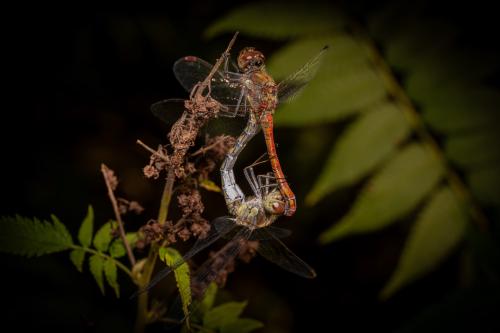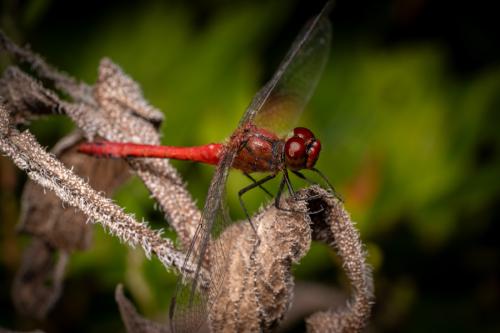Dance of love — our exclusive interview
Today, the Arthropods’ Weekly Bulletin reports exclusively on the mating of the Common Darter and interviews Lisa and Linus. The mating of this dragonfly species — which is widespread in Europe, North Africa, and Asia Minor as well as West Asia — is often described as a “dance”. But is this description accurate? Lisa and Linus, both dragonflies, share their personal experiences with us and shed some light on this fascinating natural spectacle.

Arthropods’ Weekly Bulletin:
Good afternoon, Lisa and Linus. Thank you for being here today. Let’s start with the first question. Many call your mating a “dance”. How does it feel for you?
Lisa:
Hello and thank you for inviting us! Well, the word “dance” sounds romantic and rather spontaneous, doesn’t it? But I have to say, it’s a very coordinated process. Linus cheekily passed me during the flight. I looked at him, decided it would be a good fit and we formed a tandem, with him grabbing me behind the head. It feels unique, but it’s also very practical.
Linus:
Exactly, it’s more than just a dance. It’s a union with a very specific purpose — procreation. The positioning and the attachment require a certain precision. But there are also moments of calm when we land on a branch that could be described as dance-like.
Arthropods’ Weekly Bulletin:
Before we go any deeper into the process, I’d first like to ask: Are you uncomfortable talking about something as intimate as mating?
Lisa:
No, there is nothing more natural than this part of our lives. After all, we’re not prudish people who think sex is embarrassing for whatever reason. For us, it’s an essential and beautiful aspect of life that we don’t feel uncomfortable talking about.
Arthropods’ Weekly Bulletin:
Interesting! Can you please tell us more, especially about the challenges that can occur before and after your mating?
Linus:
Sure. As a male, my job is to find a good lookout and wait for a female to fly by. There is competition, but we males keep a respectful distance from each other. The biggest challenge is to win the female for mating without having a fixed territory.
Arthropods’ Weekly Bulletin:
Linus, when you’re sitting on a lookout waiting for a female to fly by, what criteria are most important to you?
Linus:
Good question. For me, it’s mainly about the health and vitality of the female. I look for her ability to fly and her body shape, which are indicators of good egg production and general fitness. It’s not that I’m looking for specific external features, it’s more a question of overall appearance — a mixture of movement, behavior, and natural gloss in her colors.
Arthropods’ Weekly Bulletin:
Lisa, how does it feel to be patterned like this? And are you something of a little family afterward? Or do you go your separate ways?
Lisa:
“Family” — that’s also a concept from the human world. We dragonflies experience partnership completely differently. Yes, it can be romantic, but we don’t live in committed relationships. I don’t think it’s a bad thing to be “patterned”, because I can also decide freely: If I don’t like a male, I quickly fly away. After mating, when I lay my eggs, it’s crucial to find the perfect water. It must have the right temperature. And although Linus still guards me at the beginning, later I’m on my own. That may sound a bit lonely, but it’s part of my life and completely normal for me.
Arthropods’ Weekly Bulletin:
Last question. There is evidence of “mismating” with other dragonfly species. Have you heard of this or experienced anything like it?
Lisa:
Oh yes, it’s a common phenomenon. Our habitats often overlap with those of other dragonfly species, such as the Ruddy Darter, and our similarities are sometimes astonishing. I haven’t experienced this personally, but I know stories.

Linus:
Me too. It shows how complex our world is. Even with our sophisticated mating techniques — which are supposed to rule out this sort of thing — mix-ups can still happen. It’s a part of life, but we figure out our way.
Arthropods’ Weekly Bulletin:
Thank you, Lisa and Linus, for sharing your experiences and insights. You’ve given us a fascinating insight into the lives of large dragonflies.
